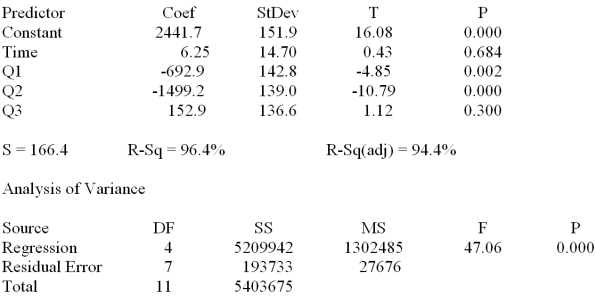Consider the following set of quarterly sales data given in thousands of dollars.  The following dummy variable model that incorporates a linear trend and constant seasonal variation was used: y (t)= B0 + B1t + BQ1(Q1)+ BQ2(Q2)+ BQ3(Q3)+ Et
The following dummy variable model that incorporates a linear trend and constant seasonal variation was used: y (t)= B0 + B1t + BQ1(Q1)+ BQ2(Q2)+ BQ3(Q3)+ Et
In this model there are 3 binary seasonal variables (Q1,Q2,and Q3).
Where
Qi is a binary (0,1)variable defined as:
Qi = 1,if the time series data is associated with quarter i;
Qi = 0,if the time series data is not associated with quarter i.
The results associated with this data and model are given in the following MINITAB computer output.
The regression equation is
Sales = 2442 + 6.2 Time - 693 Q1 - 1499 Q2 + 153 Q3  Provide a managerial interpretation of the regression coefficients for the variable "Q1" (quarter 1),"Q2" (quarter 2)and "Q3" (quarter 3).
Provide a managerial interpretation of the regression coefficients for the variable "Q1" (quarter 1),"Q2" (quarter 2)and "Q3" (quarter 3).
Definitions:
Coefficient Of Determination
A statistical measure, often denoted as R^2, that represents the proportion of the variance in the dependent variable predictable from the independent variable(s).
Positive Value
A numerical quantity greater than zero, indicating a magnitude or amount in the absence of direction or dimension.
Error Term
The part of an observation in regression analysis that the model does not explain, often considered as random noise.
Expected Value
The predicted average of a random variable, calculated by multiplying each possible outcome by its probability and summing the results.
Q9: Assume that the following data set is
Q10: Think about your drive or ride to
Q31: In simple regression analysis,r<sup>2</sup> is a percentage
Q36: A sequence of steadily increasing plot points
Q38: In utility analysis,a utility curve that shows
Q38: A county has four major hospitals: 1)Regional
Q65: When using simple exponential smoothing,the value
Q104: Consider the following analysis of variance table
Q113: In multiple regression analysis,which one of the
Q143: Consider the following data: <img src="https://d2lvgg3v3hfg70.cloudfront.net/TB1737/.jpg"